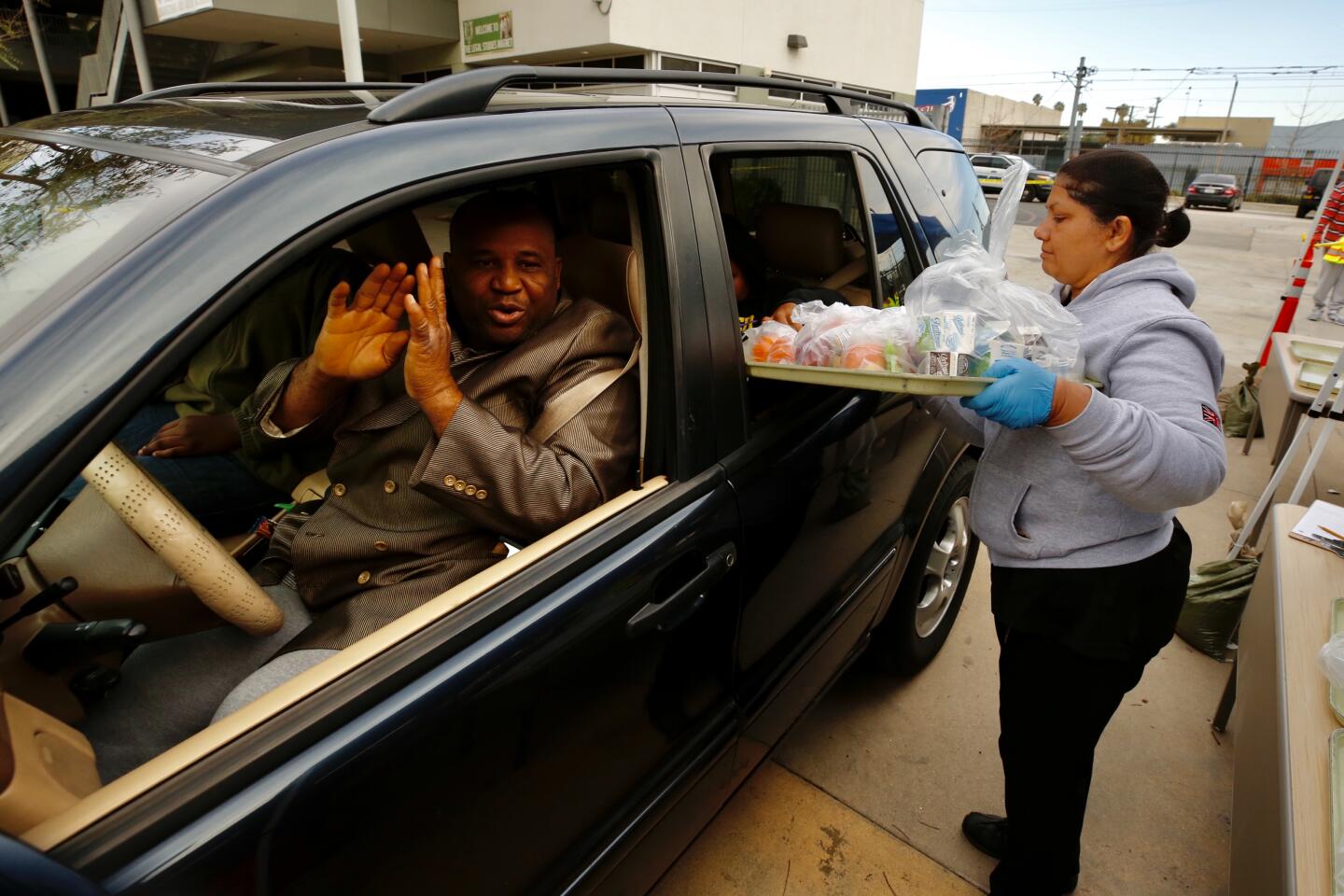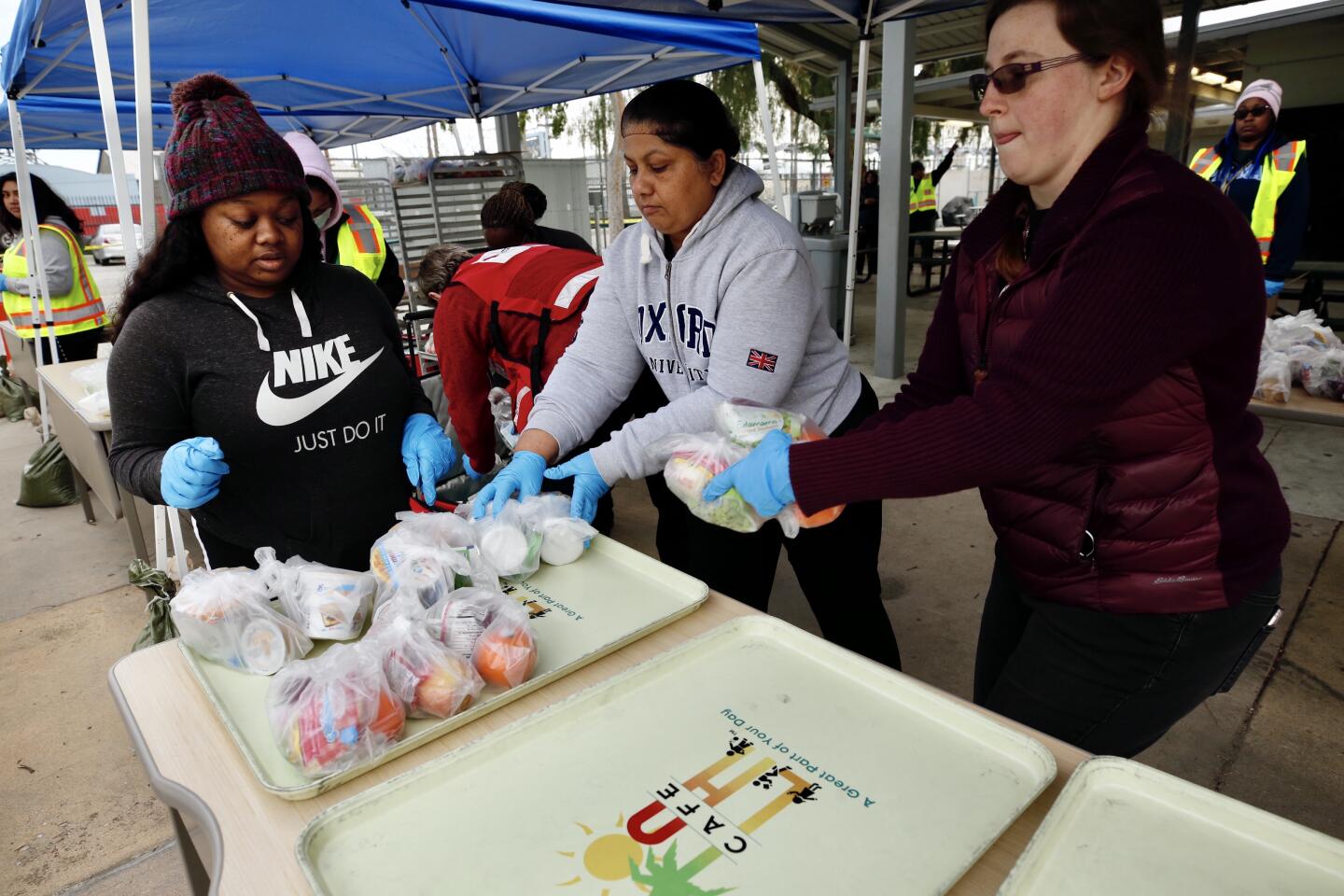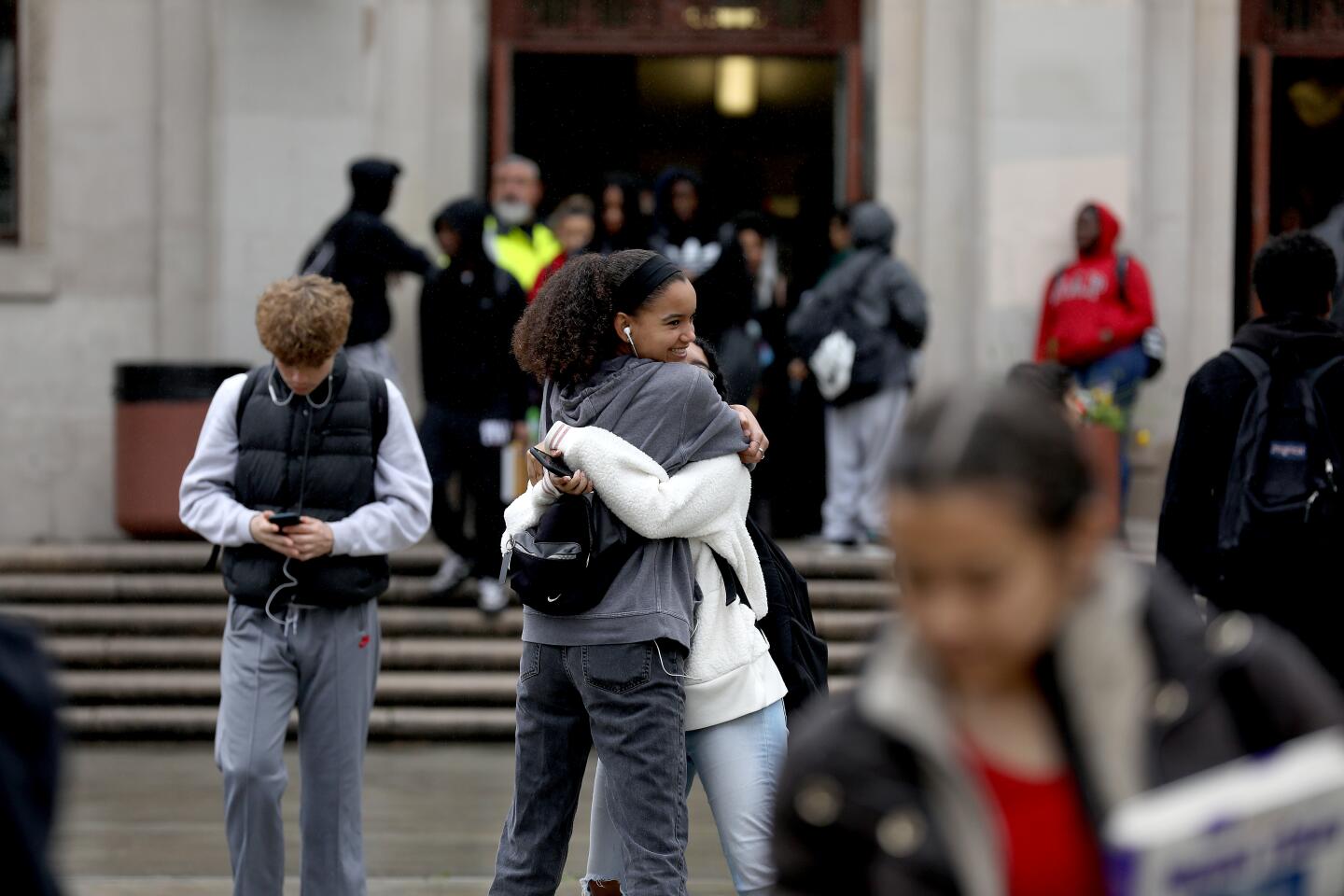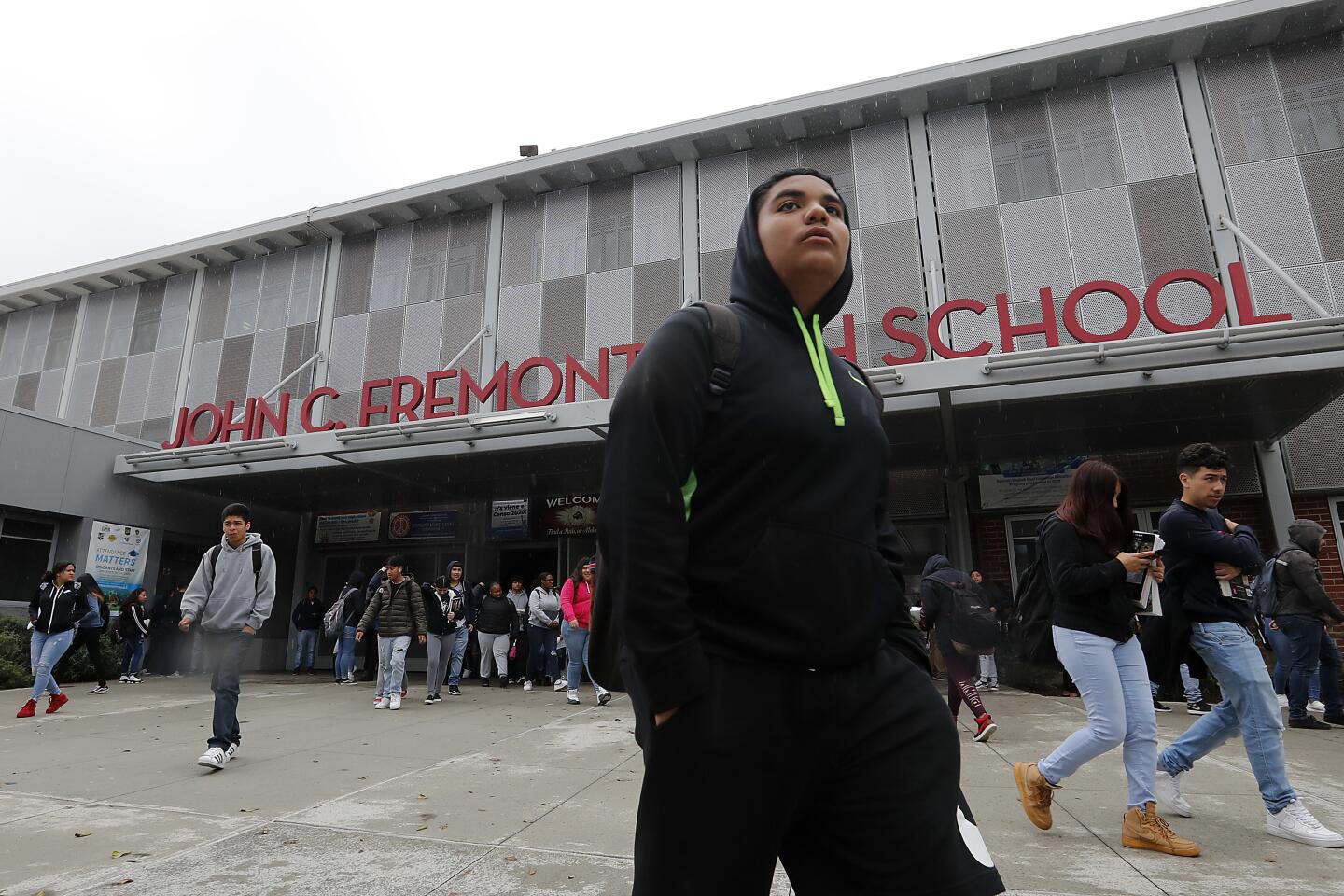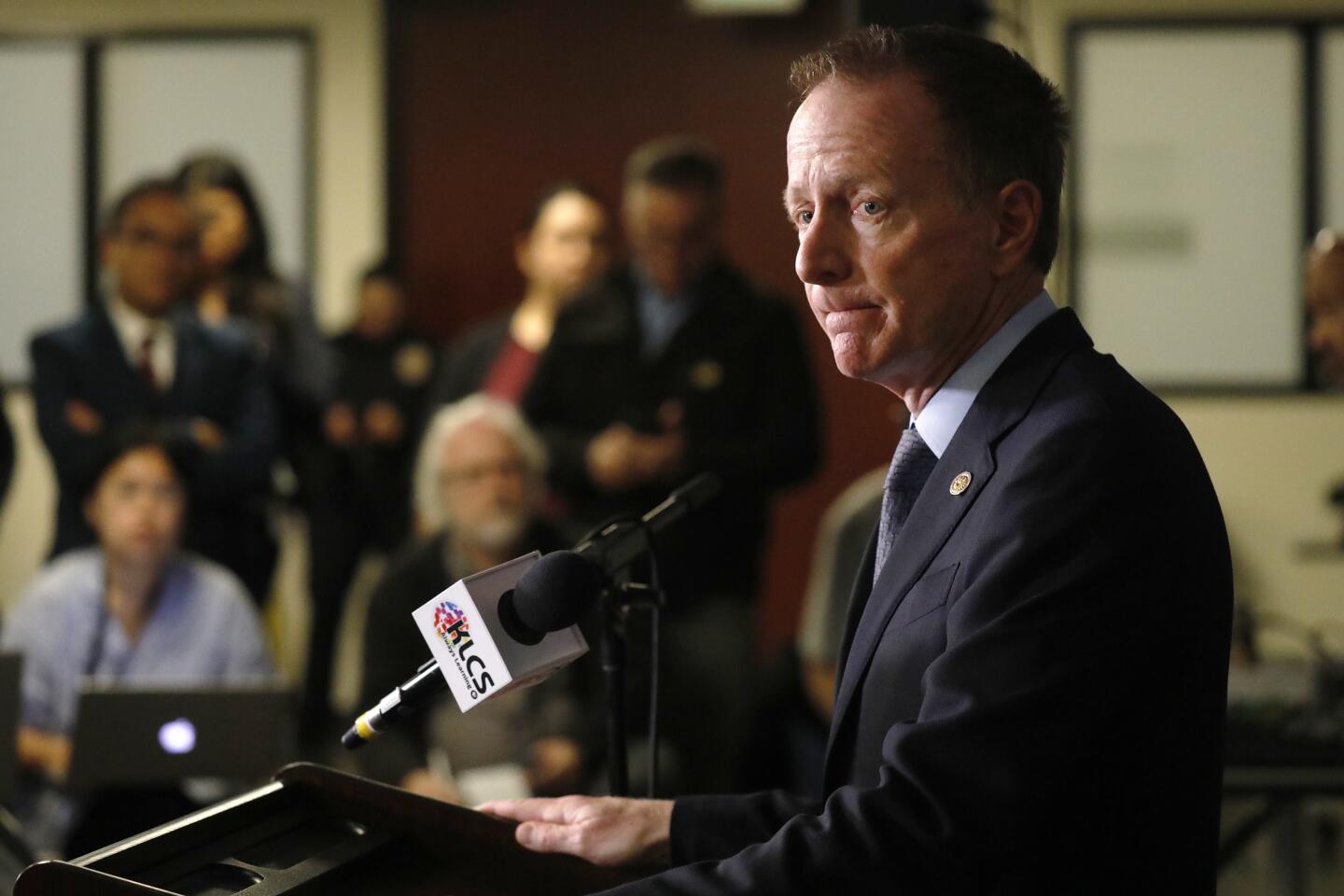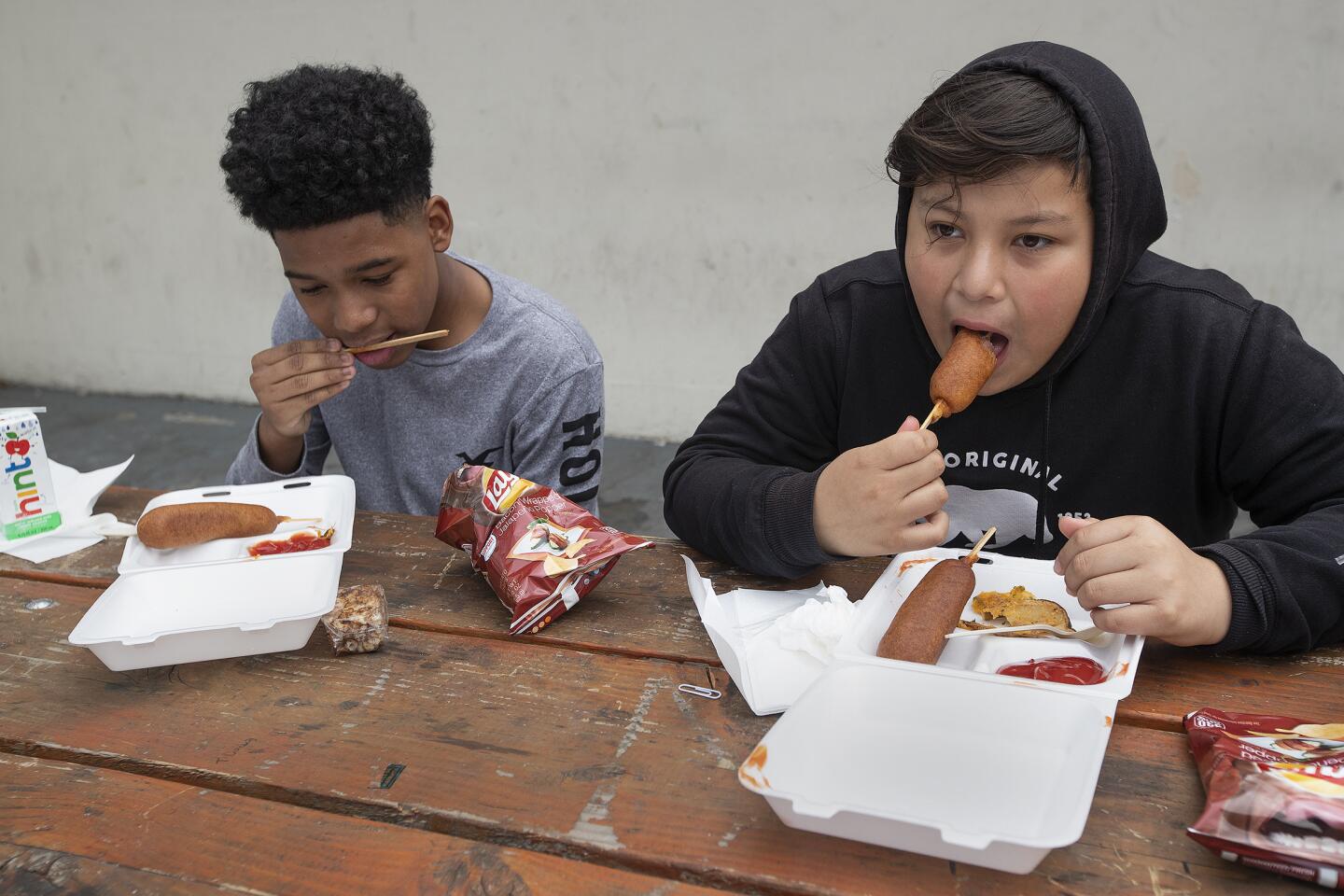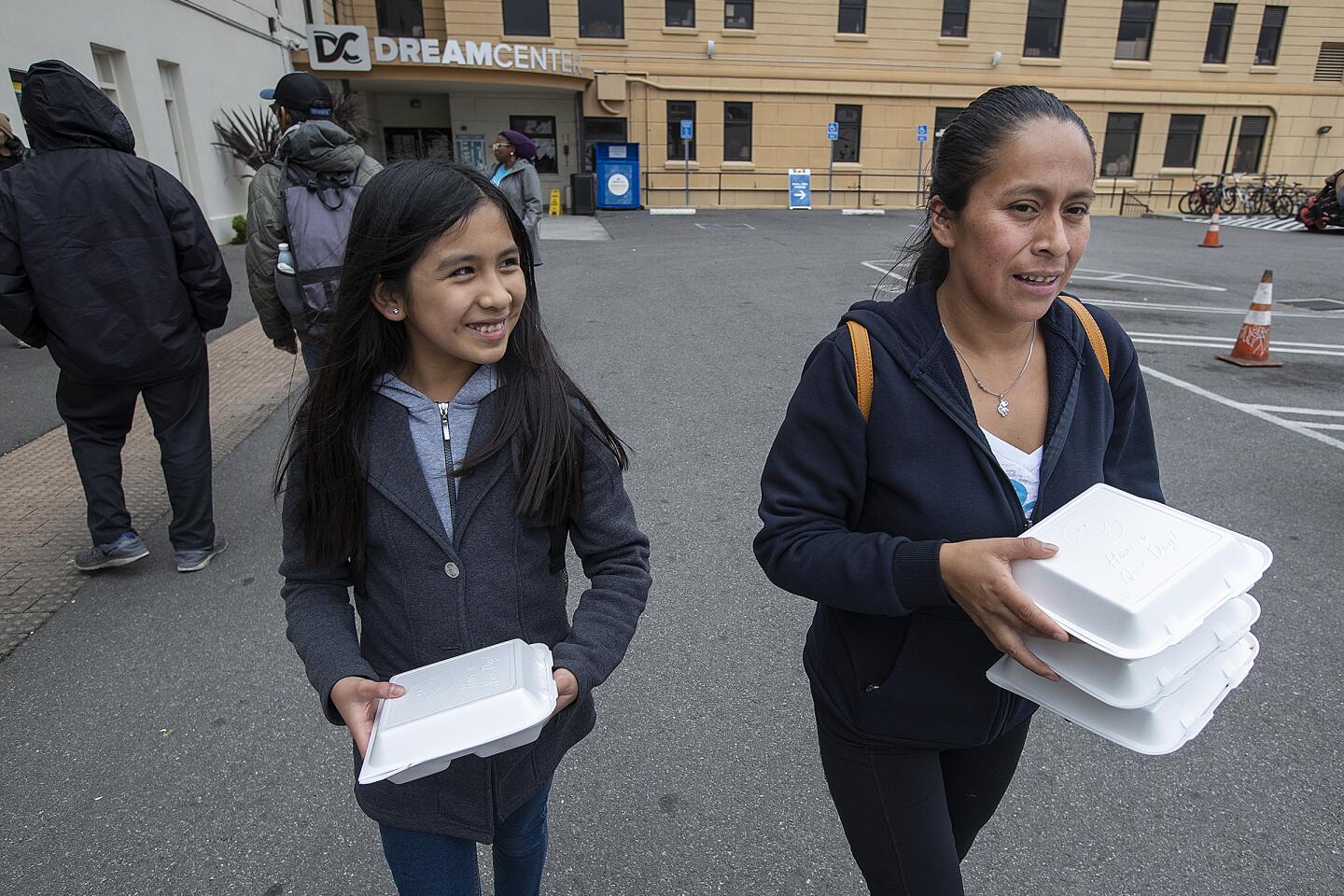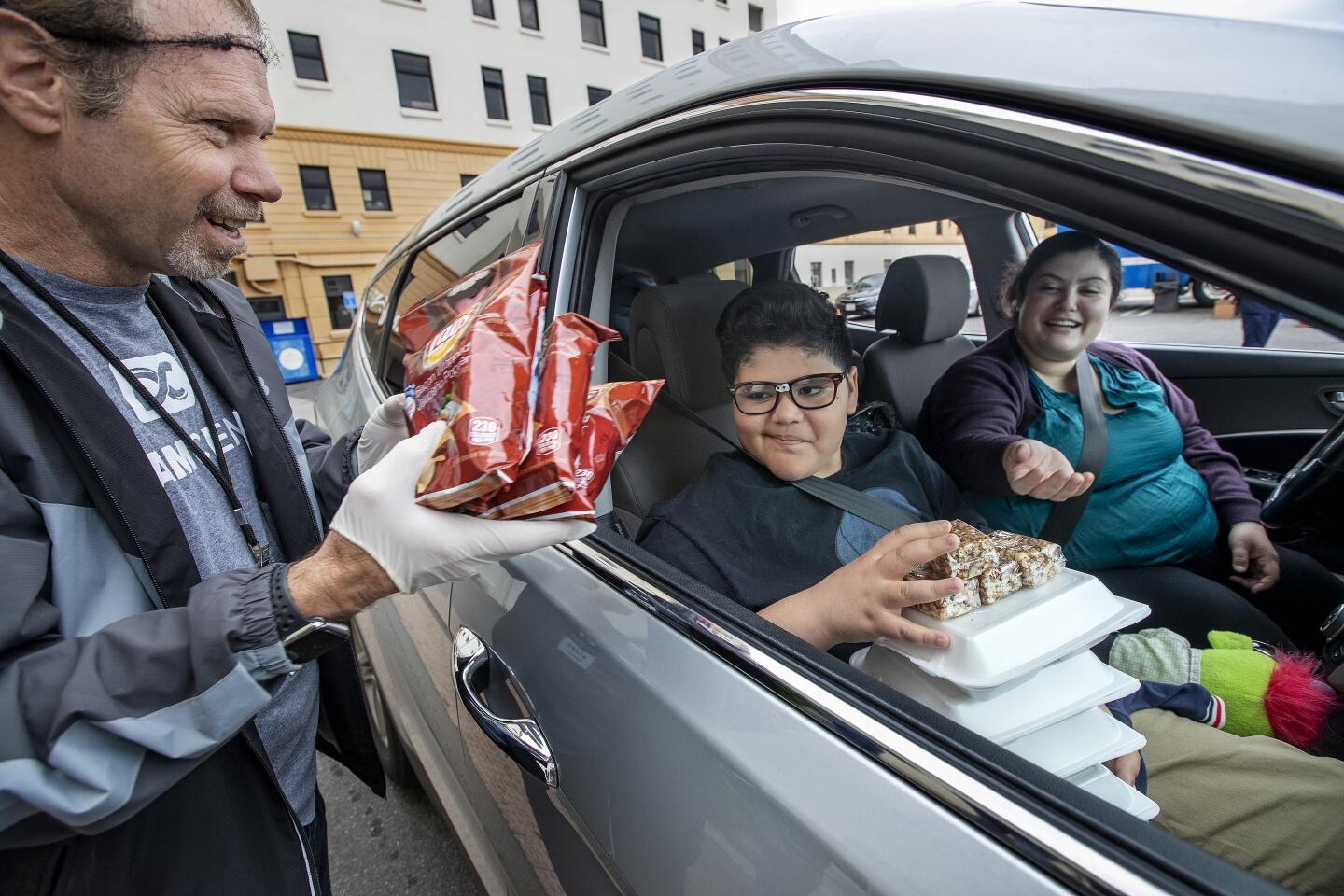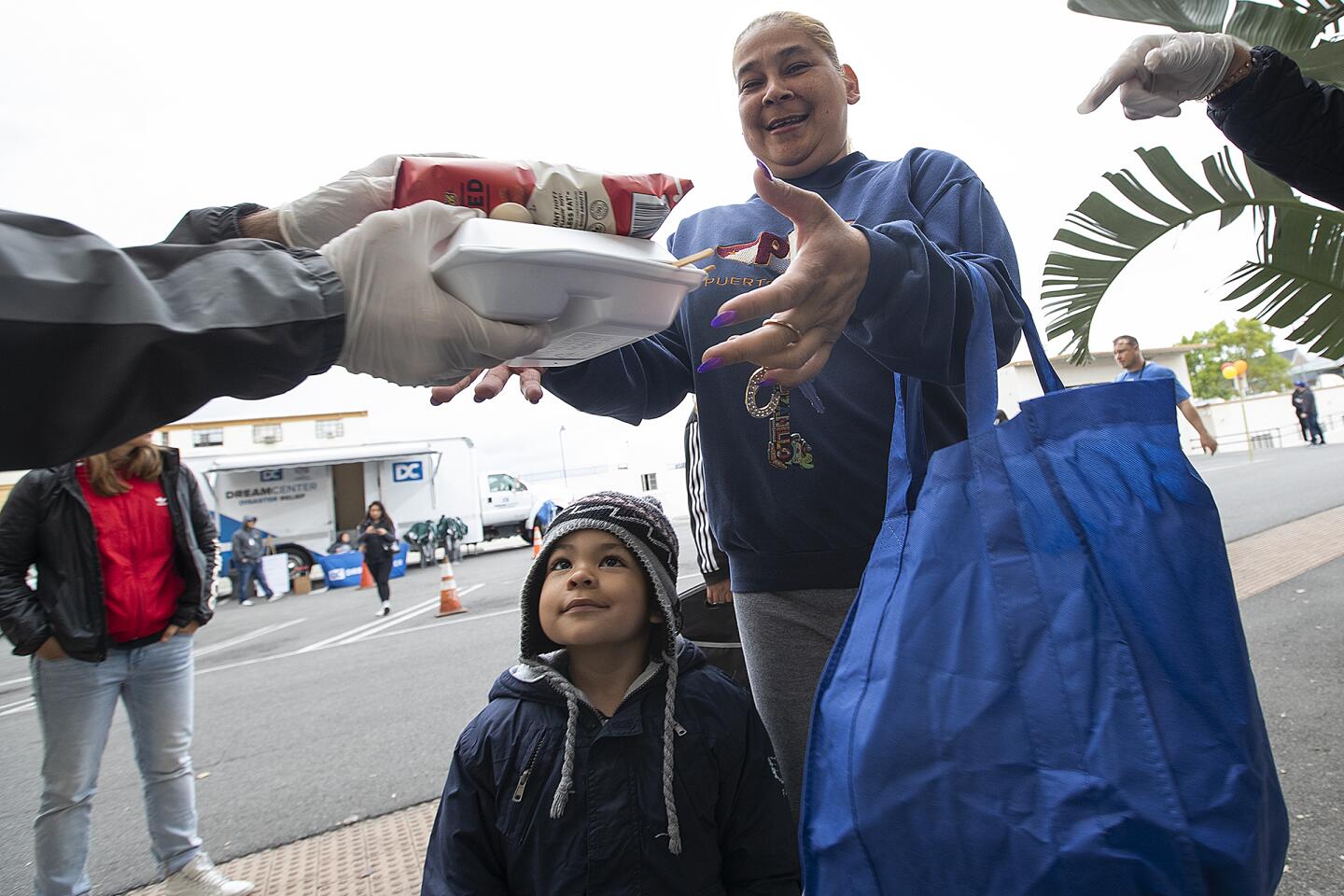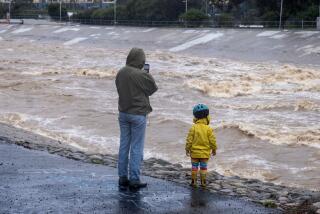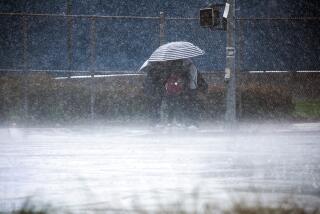California schools may not reopen this school year; LAUSD begins food distribution
About 400,000 “grab-and-go” meals were prepped and ready to be distributed Wednesday to Los Angeles students and families — a new daily ritual likely to continue for months since Gov. Gavin Newsom said all public schools in California might remain shuttered for the rest of the school year.
Los Angeles Unified officials are ramping up support and food services for the more than half a million children affected by the shutdown — most of whom rely on school for their weekday breakfast and lunch, sometimes even dinner. Across the state, school districts from San Francisco to Fresno and San Diego have been setting up to do the same.
“I’m just so impressed with so many school districts that are jumping on this so quickly to make sure their students are fed,” said Lisa Melhouse, associate director of the California Department of Education’s Nutrition Services. “I can’t say it enough.”
Districts are using school bus routes to reach students. Food trucks, community centers and food banks have also offered to find ways to help not just the students, but also their families. Partnerships have popped up around the state.
Schools shut statewide
California schools are all but shut down — a hardship for children and families in a state where 60% of students qualify for free or reduced-price meals because they are members of low-income households. In Los Angeles public schools, the percentage is even higher, with 80% of students who qualify; in Compton, it’s 83%; Pomona, 89%.
Nationwide, well over half the states in the country have also closed their public schools or ordered them to close in the coming days.
The K-12 school closures come on top of widespread actions by private colleges and state universities — including most of the University of California, to cancel in-person classes and move to online learning.
In a sober update Tuesday afternoon, Newsom told parents and educators that he expected the state’s public schools to remain closed in response to the escalating coronavirus pandemic — a disruption that would affect the education of 6.1 million students and their families.
“Don’t anticipate schools are going to open up in a week. Please don’t anticipate in a few weeks,” Newsom said. “I would plan, and assume, that it’s unlikely that many of these schools — few, if any — will open before the summer break.”
These remarks came as larger swaths of California faced even greater restrictions on movement. Orange County issued an order restricting all public gatherings, closing bars that don’t serve food and limiting restaurants to takeout and delivery service.
Millions of people across the state, including those in Palm Springs and Sacramento, were ordered to shelter in place, similar to the rules imposed Monday across the Bay Area.
Disease control experts say aggressive measures to “flatten the curve” and curb the rapid spread of the coronavirus are likely to take at least eight weeks — which would extend school closures almost to the end of the academic year.
State Supt. of Public Instruction Tony Thurmond said Tuesday night that Newsom’s comment offered an assessment of the future school year with closed campuses, but as of now, he said, “there is no declaration that school is over for the year.” He said school districts needed to be fully prepared to shift their method of instruction.
He added that officials had not yet discussed the potential option of extending the school year into the summer.
“We’re not going to know exactly what we need to do until we have a sense of how this is all going to go,” Thurmond said.
On Wednesday, Thurmond and school district leaders statewide were examining the state’s new guidelines on how to operate, including online learning and meal distribution.
Los Angeles school board member George McKenna expressed both hope and frustration Wednesday. The past few days have been a whirlwind of swift changes, but he’s not quite accepted the governor’s comments that traditional schooling on campus may be done for the year.
“I think that gives people the wrong message that it’s a definitive, that schools would be out for the rest of the year. And that’s not true. We don’t know yet,” he said. “I know that we need to keep our children safe, but we can go overboard, and you can see the community going overboard with hoarding and wiping out what’s in the markets and all of that. But I think some stability will come in a couple of days.”
McKenna said the school board and senior leadership would reassess the situation Monday as they plan next necessary steps. The district is doing what it can to provide academic support to students, he said. But L.A. Unified students already were dealing with inadequate resources and the coronavirus crisis only exacerbates that problem.
“It’s a tough thing and parents have to leave the home to go to work — those who can go to work. So what happens to the children? There’s a question we’re not answering now. We’re just saying: ‘Do the best you can and we’re with you and we love you,’ ” he said. “But it feels sometimes like we’re flying the plane and repairing it at the same time.”
The governor acknowledged the challenging road ahead and added that standardized testing would not take place this spring. “We think it is totally inappropriate for kids to worry” about being tested, Newsom said. Teachers and students “already have enough anxiety.”
On Wednesday, he canceled the testing by executive order.
The governor said he didn’t want to “mislead” Californians so he was relaying the same message he had given his children. One of his daughters was missing her school friends on Monday night, and he said he had to break it to her: “Honey, I don’t think the schools are going to open again” this school year.
“And if I could tell my daughter that, and not tell your daughter that, or the people, then I’m not being honest or true to the people of the state of California.”
Plans for continued learning
Linda Darling-Hammond, president of the State Board of Education, put all this disruption into perspective.
“We haven’t had this kind of shutdown of civil society or schools since the Spanish influenza in 1918,” she said. “It’s been a century since we saw anything like this. And, in that case as well, whole cities had to close down. So the magnitude is enormous.”
She said this moment called for families and communities to reflect on what they need and care about most.
“School is one thing, but there are going to be people losing their jobs,” she said. “People who need to be able to pay rent, people that need to be able to eat, and we have to be able to take care of that as well.”
All hands in state government and the private sector, she said, “are stepping up to assist or provide guidance” to school districts, she said. The private sector has been assisting, with broadband access for low-income families, for example.
She acknowledged that the educational inequality between the rich and poor could be exacerbated initially by the shutdown of schools. But she hopes “a lot more kids are going to have devices in the home, and a lot more neighborhoods are going to have bandwidth that didn’t have it because of all of the contributions that are coming in.”
Schools will quickly develop new ways to teach and learn with technology, she said. “I don’t think school will go back to being entirely the way it was in the country.”
In a video message to students and families, San Francisco Supt. Vincent Matthews said the district has posted online learning programs, but participation was optional.
“We know many people are at a different place, we know some people want learning to continue and urgently need it, and others are at a place where they’re just saying, ‘Right now, I just need to get me and our family together,’” he said. “We want you to take care of yourself right now, get yourself together, and whenever you’re ready to do what you need to do, we’ll be here for you.”
Teachers in most closed Los Angeles schools are trying to continue instruction through online coursework and extended homework assignments. L.A. Unified also has partnered with PBS SoCal to provide expanded educational programming.
Los Angeles Mayor Eric Garcetti, who has issued his own unprecedented orders, closing down bars, gyms and dining in restaurants, said on Tuesday that the governor’s warning on school closures came as no surprise.
He sympathizes with the difficulties many families are facing, and he himself has suddenly become a science and social science teacher at home for his daughter.
The city is looking into best practices around the country, and up and down California, to see what childcare could be provided. Broadband access and the ability to continue learning are all concerns, he said, but the health considerations must remain paramount.
“We know this will be a tough period,” he said, “but we know the most loving thing you can do for your child is to make sure that they don’t get hit by COVID-19, that they don’t spread it to your loved ones.”
Schools feed children and families
At Dorsey High School in southwest L.A., volunteers, including a Red Cross contingent, were at work before 6 a.m. setting up tents and tables and handing out plastic disposable gloves and hairnets. A police officer patrolled a gate by the entrance, and yellow tape marked a pathway winding through campus to the distribution area. Cafeteria workers inside assembled and packed cold meals into translucent white plastic bags.
The high school is one of 60 food distribution centers scattered throughout the LAUSD, the nation’s second-largest school district, where families and other community members are invited to pick up two meals per person between the hours of 7 and 10 a.m. All the locations are set up for both drive-through and walk-up distribution.
L.A. schools Supt. Austin Beutner said no one would be turned away, whether or not they have a connection to the school system.
“Our intent is to serve children, but if adults ask, we will offer, and we’re going to serve those in need,” Beutner said. “These are not ordinary days. ... Our goal is to help as many as we can.”
Other districts across the state have already taken steps in recent days.
In San Francisco, the district is providing breakfast, lunch, fresh fruit, vegetables and milk, with additional food offerings thanks to private funding to cover meals “that were previously unfunded by federal programs.”
No identification or proof of enrollment is needed to pick up food, officials said, but the priority is to support children.
“We’re operating with a sense of urgency, aggressiveness and intelligence, but also with grace and compassion,” Matthews said.
More to Read
Sign up for Essential California
The most important California stories and recommendations in your inbox every morning.
You may occasionally receive promotional content from the Los Angeles Times.
